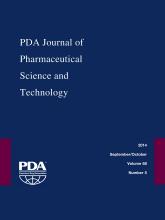Abstract
Pharmaceutical packaging/delivery systems and medical devices are characterized via a controlled extraction study as part of the development process for new pharmaceutical products. The purpose of this study is to determine compounds that may be extracted from the packaging using various solvents and exposure conditions. Results generated from a controlled extraction study serve to evaluate the suitability of the materials in the package configuration as well as provide an assessment of compounds that may potentially leach into the drug product. Analysis of extract samples generated during a controlled extraction study is performed utilizing multiple analytical methodologies to help establish a complete extractable profile regardless of the polarity, volatility, or other unique physical properties of each compound that may be present. The work presented in this article describes a method for the analysis of non-volatile as well as thermally labile, or otherwise not suited for analysis by gas chromatography, semi-volatile compounds from extraction samples. An ultra-high performance liquid chromatographic system with both atmospheric chemical ionization mass spectrometric and ultra violet detectors is used as the platform for the method. Adequate separation and retention is achieved for a mix of model compounds representing a wide range of common extractables within a 22 min analysis time. Ionization of this diverse range of compounds is also achieved with acceptable responses in the total ion chromatography data. Finally, analysis of extraction samples directly, even those comprised of non-compatible organic solvents, is demonstrated with no significant impact on the chromatography. Three case studies are presented to further illustrate method performance and its use for controlled extraction samples.
LAY ABSTRACT: Pharmaceutical packaging/delivery systems and medical devices are characterized via a controlled extraction study as part of the development process for new pharmaceutical products. The purpose of this study is to determine compounds that may be extracted from the packaging using various solvents and exposure conditions. Results of this work serve to evaluate the suitability of the material for use in the package as well as provide an assessment of compounds that may potentially contaminate the drug product. Analysis of extract samples generated during a controlled extraction study is performed utilizing multiple analytical methodologies to help establish a complete extractable profile regardless of the unique physical properties of each compound that may be present. The work presented in this article describes a method for the analysis of non-volatile as well as semi-volatile compounds from extraction samples. Separation and detection of a diverse range of extractables were demonstrated in a 22 min analysis time. Three case studies are presented to further illustrate method performance and its use for controlled extraction samples.
- © PDA, Inc. 2014
PDA members receive access to all articles published in the current year and previous volume year. Institutional subscribers received access to all content. Log in below to receive access to this article if you are either of these.
If you are neither or you are a PDA member trying to access an article outside of your membership license, then you must purchase access to this article (below). If you do not have a username or password for JPST, you will be required to create an account prior to purchasing.
Full issue PDFs are for PDA members only.
Note to pda.org users
The PDA and PDA bookstore websites (www.pda.org and www.pda.org/bookstore) are separate websites from the PDA JPST website. When you first join PDA, your initial UserID and Password are sent to HighWirePress to create your PDA JPST account. Subsequent UserrID and Password changes required at the PDA websites will not pass on to PDA JPST and vice versa. If you forget your PDA JPST UserID and/or Password, you can request help to retrieve UserID and reset Password below.






